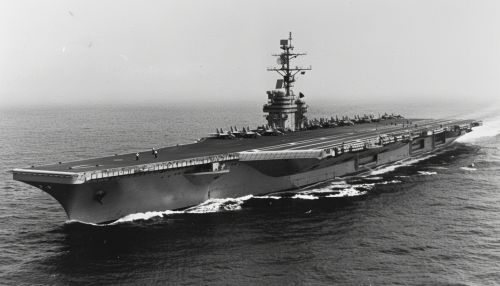USS Saratoga (CV-3): Difference between revisions
(Created page with "== USS Saratoga (CV-3) == The USS Saratoga (CV-3) was a Lexington-class aircraft carrier built for the United States Navy during the 1920s. She was the second aircraft carrier of the United States Navy and was commissioned in 1927. Saratoga played a significant role in the Pacific Theater during World War II, participating in numerous battles and earning multiple battle stars for her service. <div class='only_on_desktop image-preview'><div class='image-preview-loader'>...") |
No edit summary |
||
| Line 3: | Line 3: | ||
The USS Saratoga (CV-3) was a Lexington-class aircraft carrier built for the United States Navy during the 1920s. She was the second aircraft carrier of the United States Navy and was commissioned in 1927. Saratoga played a significant role in the Pacific Theater during World War II, participating in numerous battles and earning multiple battle stars for her service. | The USS Saratoga (CV-3) was a Lexington-class aircraft carrier built for the United States Navy during the 1920s. She was the second aircraft carrier of the United States Navy and was commissioned in 1927. Saratoga played a significant role in the Pacific Theater during World War II, participating in numerous battles and earning multiple battle stars for her service. | ||
[[Image:Detail-91397.jpg|thumb|center|USS Saratoga (CV-3) at sea.|class=only_on_mobile]] | |||
[[Image:Detail-91398.jpg|thumb|center|USS Saratoga (CV-3) at sea.|class=only_on_desktop]] | |||
=== Design and Construction === | === Design and Construction === | ||
Latest revision as of 11:21, 21 June 2024
USS Saratoga (CV-3)
The USS Saratoga (CV-3) was a Lexington-class aircraft carrier built for the United States Navy during the 1920s. She was the second aircraft carrier of the United States Navy and was commissioned in 1927. Saratoga played a significant role in the Pacific Theater during World War II, participating in numerous battles and earning multiple battle stars for her service.


Design and Construction
The USS Saratoga was originally laid down as a battlecruiser but was converted to an aircraft carrier during construction to comply with the Washington Naval Treaty of 1922. The treaty aimed to prevent an arms race by limiting naval construction. The ship was built by the New York Shipbuilding Corporation in Camden, New Jersey.
Saratoga had a length of 888 feet (271 meters), a beam of 106 feet (32 meters), and a draft of 30 feet (9.1 meters). She displaced 33,000 tons and could carry a complement of around 2,200 officers and enlisted men. The ship was powered by four geared steam turbines, which drove four propellers, and could reach a top speed of 33.25 knots (61.58 km/h).
Armament and Armor
Saratoga's armament consisted of eight 8-inch (203 mm) guns in four twin turrets, twelve 5-inch (127 mm) anti-aircraft guns, and numerous smaller anti-aircraft weapons. The ship also had an armor belt ranging from 5 to 7 inches (127 to 178 mm) in thickness, with deck armor up to 2 inches (51 mm) thick.
Early Service
Upon her commissioning on November 16, 1927, Saratoga joined the Pacific Fleet. She participated in various fleet exercises and training operations, helping to develop carrier tactics and doctrine. In the 1930s, Saratoga was involved in several significant fleet problems, which were large-scale naval exercises that tested the Navy's strategies and capabilities.
World War II Service
Pearl Harbor and Early Operations
When the Japanese attacked Pearl Harbor on December 7, 1941, Saratoga was undergoing maintenance on the West Coast and was not present during the attack. She quickly returned to service and was involved in the early operations of the Pacific War, including the reinforcement of Wake Island.
Battle of the Eastern Solomons
One of Saratoga's most notable engagements was the Battle of the Eastern Solomons in August 1942. During this battle, Saratoga's aircraft played a crucial role in sinking the Japanese light carrier Ryujo. However, Saratoga herself was torpedoed by a Japanese submarine and had to undergo repairs.
Guadalcanal Campaign
Saratoga returned to action in the Guadalcanal Campaign, providing air support for the Marines fighting on the island. Her aircraft conducted numerous strikes against Japanese positions and shipping, contributing significantly to the Allied efforts in the Solomon Islands.
Later War Service
After repairs and refits, Saratoga continued to serve in the Pacific, participating in the Gilbert and Marshall Islands campaign, the Battle of the Philippine Sea, and the Battle of Iwo Jima. She was also involved in the Okinawa campaign, where she provided air support for the invasion forces.
Post-War Service and Decommissioning
Following the end of World War II, Saratoga was used to transport American servicemen back to the United States as part of Operation Magic Carpet. In 1946, she was assigned to be a target ship for the Operation Crossroads nuclear tests at Bikini Atoll. Saratoga survived the first test but was sunk by the second test on July 25, 1946.
Legacy
The USS Saratoga (CV-3) earned seven battle stars for her World War II service. Her contributions to the development of carrier warfare and her role in key battles of the Pacific Theater have cemented her place in naval history. Today, the wreck of Saratoga remains a popular site for divers and a poignant reminder of the sacrifices made during the war.
